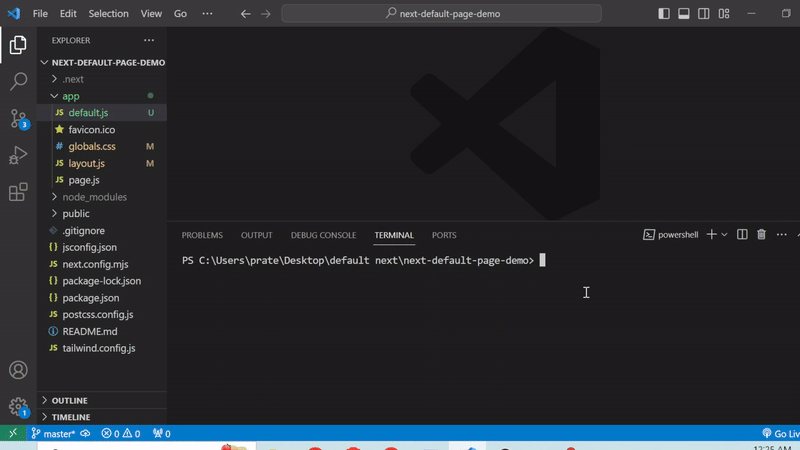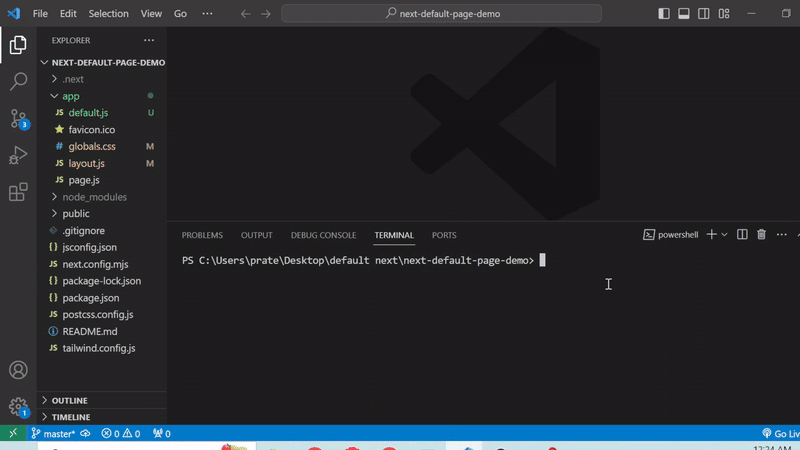Next JS File Conventions: default.js
Last Updated :
02 Apr, 2024
Default.js is a very important file in Next.js projects, serving as a default entry point of the project. Also, while using Next.js, sometimes you soft navigate (move between pages without fully reloading the page). In that case, Next.js keeps track of the pages you were on. However, In case of hard navigation (fully reloading the page), such as clicking a link or refreshing the browser, Next.js can’t remember where you were. In this scenario, Next.js serves as a default page created by you.
Prerequisites:
Steps to Create a Default Page:
Step 1: Create a next-app by running the following command and enter into the created directory by running the following commands.
npx create-next-app my-app
cd my-app
Note: While creating a Next.js app you will be asked for configurational details. Make sure that you use the app-router there.
Folder Structure:

project structure
Updated Dependencies: There is no update in the dependencies.
Example 1: Here is the code for the usage of Default.js page in Next.js
Javascript
// app/default.js
import React from 'react'
const DefaultPage = () => {
return (
<div className='w-full p-12 h-[100vh] bg-blue-400'>
<p className='text-gray-100 font-bold tracking-wider'>
Next.js
</p>
<p className='mt-6 font-light
text-sm bg-white
p-6 rounded-md'>
I am the
<span className='text-blue-500 font-bold'>
Next.js Default Page
</span>.
</p>
<p className='text-xs mt-4 p-6
bg-gray-100 font-light
rounded-md shadow-md'>
Default.js is a very important file in Next.js
projects, serving as a default entry point
of the project. Also, while using Next.js,
sometimes you soft navigate
(move between pages without fully reloading the page).
In that case, Next.js keeps track of the pages
you were on. However, In case of hard
navigation (fully reloading the page),
such as clicking a link or refreshing the browser,
Next.js can't remember where you were. In this
scenario, Next.js serves as a default page
created by you.
</p>
</div>
)
}
export default DefaultPage
Run the following command to start the App:
npm run dev
Output:

Example 2: Here is another example of Next.js default.js page.
Javascript
// app/default.js
import React from 'react';
const DefaultPage = () => {
return (
<div className="flex items-center justify-center
min-h-screen bg-gradient-to-r
from-red-200 to-pink-600">
<div className="bg-white rounded-lg
shadow-lg p-8 max-w-md w-full">
<h1 className="text-3xl font-bold
text-gray-800 mb-4">
Welcome to Next.js
</h1>
<div className="text-gray-700">
<p className="mb-4">
You've reached the default page of Next.js.
</p>
<p className="mb-4">
Default.js is a very important file in
Next.js projects, serving as a default
entry point of the project. Also,
while using Next.js, sometimes you soft
navigate (move between pages without fully
reloading the page). In that case, Next.js
keeps track of the pages you were on.
However, In case of hard navigation
(fully reloading the page),
such as clicking a link or refreshing the
browser, Next.js can't remember where you
were. In this scenario, Next.js serves as a
default page created by you.
</p>
</div>
<p className="text-gray-600 text-sm mt-4">
@GeeksforGeeks ❤️
</p>
</div>
</div>
);
};
export default DefaultPage;
To run the app, execute the following command:
npm run dev
Output:

Share your thoughts in the comments
Please Login to comment...